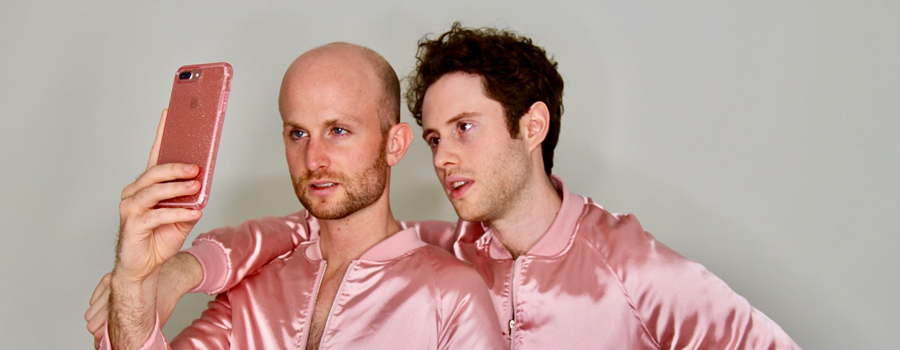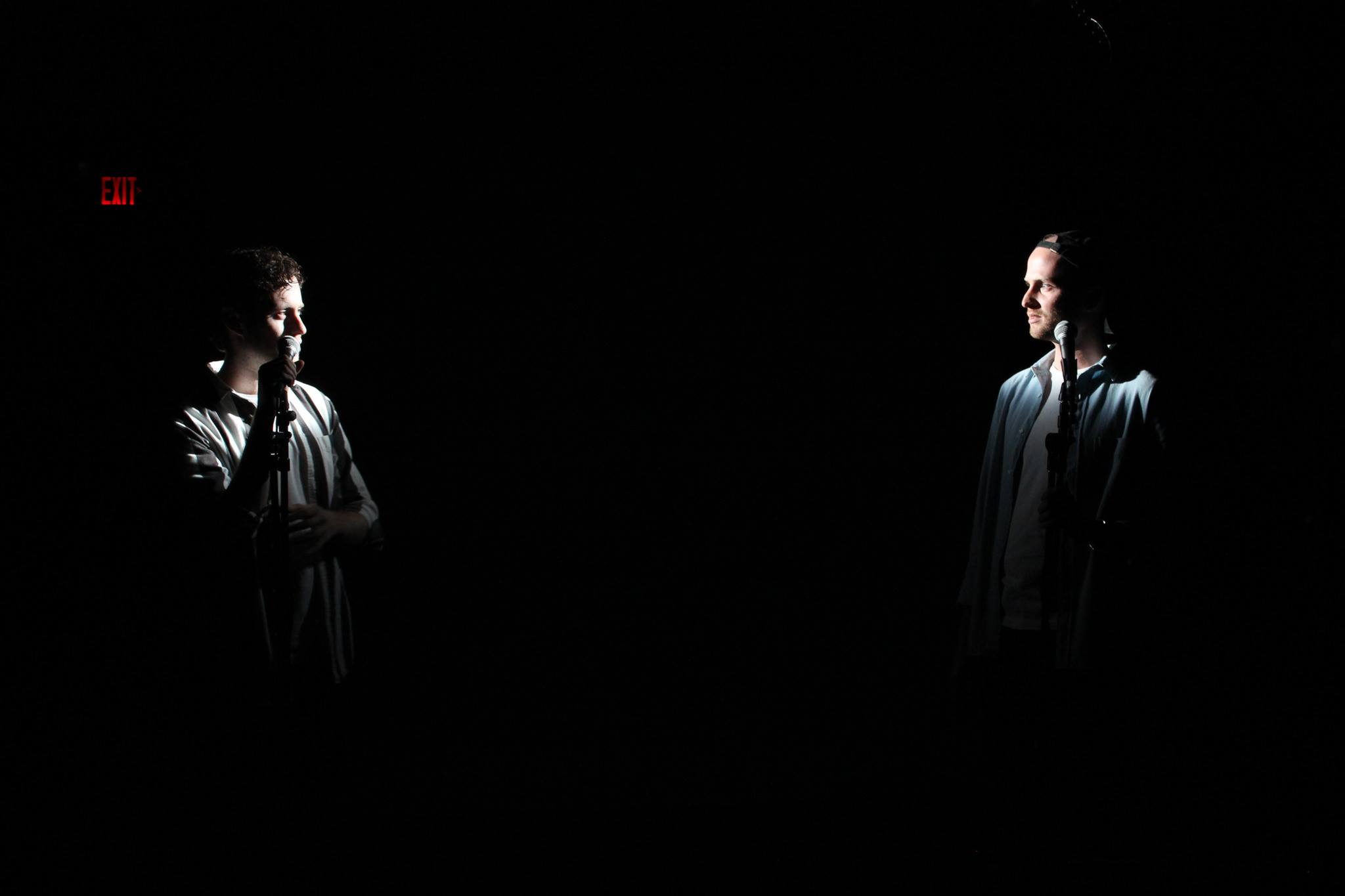Review of A Doll’s House, Part 3, Wesleyan Center for the Arts
Those two video-theater boys are back! Michael (Breslin) and Patrick (Foley)—the duo responsible for This American Wife, a playful video-theater piece that debuted as a short at the Yale Cabaret’s Satellite Festival, then progressed to the Cabaret’s season 50, then made quite a splash at New York Theatre Workshop Next Door last summer—bring their second video-performance piece, A Doll’s House, Part 3, to the Wesleyan Center for the Arts for a one-night-stand. The show is part of a theater program, “Hyperbole in Performance,” hosted by Wesleyan. The play debuted at Ars Nova ANT Fest last June in New York.
Michael Breslin, Patrick Foley
Fans of This American Wife may feel a reassuring familiarity—yes, the show has Michael and Patrick and video cameras, and the show is abetted by their frequent collaborators, Catherine María “Cat” Rodríguez and dramaturg Ariel Sibert. But, unlike Wife, Doll’s House isn’t all about its creators. Michael and Patrick, in pageboy wigs and boyish shorts and bowties, play the two brothers abandoned when Nora Helmer famously walked out on her husband Torvald at the close of Ibsen’s A Doll’s House. Patrick is Ivar, the brunette, and Michael is Bob, the blonde. Ivar has issues, claiming to identify as Italian due to the month or so the family spent in Tuscany while he was a toddler. Voicing a reassuring mantra—“Feelings are facts”—Bob, after initially dismissing his brother’s difference, validates Ivar’s Italian identity. The argument is delivered with a very amusing—and very catty—invocation of hyper-sensitivity and the always fraught path to making one’s obsessions socially acceptable.
This is the third iteration of M+P’s Doll’s House and, from what I understand, the first and now the third include second-year Yale School of Drama actor Zoe Mann as the brothers’ younger sister, Emmy. The boys, naturally, are theater-struck and spend most of their time enacting choreography—a tarantella routine—they are at pains, with short tempers and abuse bordering on hysteria, to teach to Emmy. Off to one side of the stage at her own camera and laptop, Rodríguez, as Content Kween, operates some of the tech and breaks in from time to time with seemingly freeform reminiscence while applying make-up on camera. Kween’s narrative trades in the dark side of sibling rivalry as she recounts episodes of torture, involving waterboarding, between herself and her sister.
The notion of torture as a family event seems to be the main idea here, as the Helmer children torture themselves and each other with the glaring absence of Mom. Michael and Patrick assure the audience that they haven’t read nor seen Lucas Hnath’s A Doll’s House, Part 2 (he’s referred to a few times as “the writer with a ponytail”), but it’s entirely fitting that they should enact the two characters absent from “Part 2.” In the original A Doll’s House, of course, the children are little and if they appear onstage are played by child-actors. In Hnath’s revisiting, only Emmy, as a young adult, appears. The boys, clearly, have been suppressed, and that’s reason enough for Michael and Patrick to use their unique brand of video/performance art to bring Bob and Ivar to life.
The best bits have to do with the unreal world of theater as conceived by the brothers, all the while insisting on “realism.” Ivar lip-synchs on camera with impressive precision to “What’s the Use of Wonderin’” from Carousel and, early on, dominates a microphone to give us a sense of unsettling intimacy, attempting to trigger Autonomous Sensory Meridian Response (ASMR). Foley plays Ivar as borderline psychotic, the most unstable of the kids and the one who needs things to be a certain way to support his sense of his own stardom.
Breslin’s Bob is a shade more unassuming. He has a knack for enacting a kid utterly caught up in a fantasy world, only to have to shake himself out of it for one of his brother’s tirades or something more mundane. His pet peeve is theater folks, particularly actors, but perhaps authors of new plays even more. His on-camera monologue as a hotel clerk bristling at a theater person trying to check in digs at the pretensions of actors and the kind of careerist moves a writer trying to cash-in on a classic might well indulge in. It’s scary and hilarious.
Near the end, Emmy gets her big moment, an impassioned speech at the camera, addressed to her brothers and, by extension, the sensibility of the two impresarios behind this piece. Mann runs deliberately in and out of character, or rather blends her own voice with her character’s—much as M+P do as well—in service to a wit’s-end protest at the way her character is construed by the play. She works through her ire, coming—with a benign though possibly tongue-in-cheek vision—to an understanding of what’s required of her. She’s forced to be Mom, and that’s a part impossible for her to ever get right. And so she gets to be the whipping-girl forever, unless she learns to dominate the scenario.
Throughout there are digs aplenty at the Yale School of Drama, as the program that has fostered everyone involved with the show, and one of the more beguiling aspects of Doll’s House, Part 3, is the tantalizing glimpse of the fractious world “behind the scenes.” Not only backstage at plays, but in the rehearsal and workshop rooms, the spaces that, as a kind of dollhouse world of make believe, seem to suggest the possibility of remaking the world in one’s own image while being subjected, at each step of the way, to the dominant focus in the room.
As a form of child’s play—acting out to cope with trauma and loss—the piece has its therapeutic gestures; as a form of critique, written to cope with the unnerving path to theatrical success, A Doll’s House, Part 3, is both funny and sad, vicious and vulnerable, a routine and a ritual where tragedy means forever going unseen by the one viewer you want desperately to reach. As dramaturg Ariel Sibert writes in the show’s notes: “All claims to the Real are pleas for redemption.”
A Doll’s House, Part 3
By Michael + Patrick
In collaboration with Catherine María Rodríguez, Zoe Mann, and Ariel Sibert
Producer: Rachel Shuey; Stage Manager: Devin Fletcher; Dramaturg: Ariel Sibert; Costume Design: Cole McCarty; Lighting Design: Krista Smith; Sound Design: Michael Costagliola; Beats: Ashley Jean Vanicek
Cast: Michael Breslin, Patrick Foley, Zoe Mann, Catherine María Rodríguez
Hyberbole in Performance is a collaboration between the Center for the Humanities, the Center for the Arts, and the Theater Department at Wesleyan University
Ring Family Performing Arts Hall
Wesleyan University
February 14, 2019








